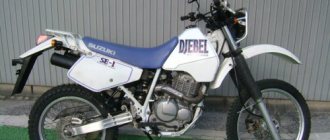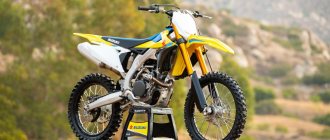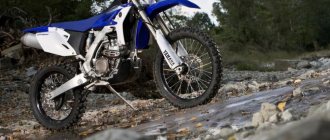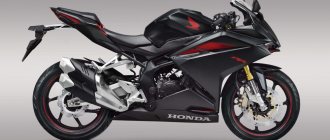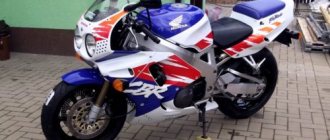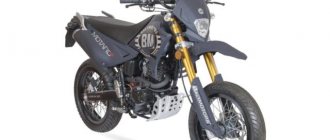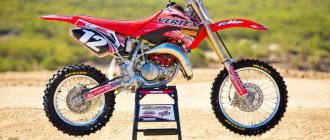| Yamaha TT250R (Open Enduro), 1993-2004 | Yamaha TT250R Raid, 1994-1996 | Yamaha TT-R250, 1999-2006 |
Soft enduro model Yamaha TT250R
appeared in 1993 in the Japanese domestic market and was often sold with the
Open Enduro
.
Since 1994, the model line has been replenished with a new modification, called the Yamaha TT250R Raid
. This modification positioned itself as a motorcycle for long trips, equipped with a classic round headlight, larger luggage mounts and a larger fuel tank (16 l instead of 9 l).
The regular enduro modification of the Yamaha TT250R began to be supplied to European countries in 1996 (first to the UK), from 1999 to Australia, and from 2003 to the USA. Also, 1996 was the last year of production of the touring version of the Raid.
In 2004, the Yamaha TT250R model finally left the market.
It is important to note that since 1999, an export modification of the Yamaha TT-R250
(not to be confused with the Yamaha TT250R discussed above). It was distinguished by the absence of mirrors, overall dimensions, tires, the presence of a simple tripmeter (instead of a full-fledged instrument panel), fuel tank (10 l instead of 9 l), chassis geometry, etc. This model was available in the markets of Europe and North America until 2006 inclusive .
Very often in reviews and reviews the TT250R and TT-R250 models are confused. Although similar in appearance and technically, they still have a fairly large number of differences, and therefore must be considered separately. The difficulty in identifying both models and the resulting confusion is most likely due to the fact that the Japanese version of the Yamaha TT250R (Open Enduro) was also available in foreign markets and in the same countries as the export Yamaha TT-R250.
Among the key features of the TT250R / TT-R250 series, it is worth noting a steel frame, a 1-cylinder 4-valve air-cooled engine, long-travel suspensions, wheels measuring 21′ and 18′, disc brakes, a 6-speed gearbox and from 113 kg of dry weight.
The main competitors of the Yamaha TT-R250R Raid in the class:
- Honda XR 250 Baja
- Suzuki Djebel 250
- Kawasaki KLR 250
The main competitors of the Yamaha TT-R250R / TT250R in the class:
- Kawasaki KLX 250
- Honda XR 250
- Suzuki DR 250
Brief history of the model
- 1993 - start of production and sales of the Yamaha TT250R model.
Model
: Yamaha TT250R (Japan).
Factory designation
: 4GY1.
- 1994 - appearance of the Yamaha TT250R Raid modification.
Model
: Yamaha TT250R Raid (Japan).
Factory designation
: 4GY3.
- 1995 - no significant changes.
Model
: Yamaha TT250R + Raid (Japan).
Factory designation
: 4RR1 + 4GY5.
- 1996 - The TT250R is officially available in the UK. Last year of production of the Raid modification.
Model
: Yamaha TT250R (UK);
Yamaha TT250R Raid (Japan). Factory designation
: 4MR2; 4WA1.
- 1997 is the final year of production of the TT250R for the Japanese market.
Model
: Yamaha TT250R (Japan).
Factory designation
: 4RR2.
- 1999 - Japanese TT250R only available in Australia. The appearance of the export modification TT-R250.
Model
: Yamaha TT250R (Australia);
Yamaha TT-R250 (Europe, North America). Factory designation
: 4PX5; 5GF1, 5GF2, 5GF3.
- 2000 - TT250R temporarily discontinued.
Model
: Yamaha TT-R250 (Europe, North America).
Factory designation
: 5GF4, 5GF5, 5GF6.
- 2001 - TT250R available in Europe.
Model
: Yamaha TT250R;
Yamaha TT-R250 (Europe, North America). Factory designation
: 4PX7; 5GF7, 5GF8, 5GF9.
- 2002 - no significant changes.
Model
: Yamaha TT250R;
Yamaha TT-R250 (Europe, North America). Factory designation
: 4PX8; 5GFA, 5GFB, 5GFC.
- 2003 - The TT250R is officially available in North America.
Model
: Yamaha TT250R;
Yamaha TT-R250 (Europe, North America). Factory designation
: 4PX9; 5GFD, 5GFF.
- 2004 is the last year of production of the TT250R.
Model
: Yamaha TT250R;
Yamaha TT-R250 (Europe, North America). Factory designation
: 4PXA; 5GFH, 5GFG, 5GFJ.
- 2005 - no significant changes.
Model
: Yamaha TT-R250 (North America).
Factory designation
: 5GFK, 5GFL.
- 2006 is the last year of production.
Model
: Yamaha TT-R250 (North America).
Factory designation
: 5GFN, 5GFP, 5GFR.
Restyling
Every year the Yamaha TTR 250 motorcycle was restyled. There have never been any major changes because the design of the bike is perfect. However, during operation, minor defects accumulated that required correction. Sports motorcycles usually require special attention in terms of the strength of the rear suspension, which bears a significant load. And enduro bikes even more so require monitoring of the chassis. To avoid breakdowns, it is necessary to do preventive examinations on time.
The exterior remained virtually unchanged throughout the production period. And if today, when purchasing a motorcycle secondhand, the buyer notices something that was not on the factory-produced bike, then it means that the previous owner carried out tuning and added some details of his own.
Specifications
Technical characteristics of Yamaha TT-R250 (TT250R, Raid):
| Model | Yamaha TT-R250 (TT250R, Raid) |
| Motorcycle type | enduro |
| Year of issue | 1993-2006 |
| Frame | steel |
| engine's type | 1-cylinder, 4-stroke |
| Working volume | 249 cm³ |
| Bore/Stroke | 73.0 x 59.6 mm |
| Compression ratio | 10.2:1 |
| Cooling | air |
| Number of valves per cylinder | DOHC, 4 valves |
| Fuel supply system | Carburetor, 1x Teikei Y30P |
| Ignition type | CDI |
| Maximum power | 30.0 hp (22.0 kW) at 8500 rpm |
| Maximum torque | 27.5 Nm (2.8 kg-m) at 7000 rpm |
| Clutch | Multi-disc in oil bath, cable drive |
| Transmission | 6-speed |
| type of drive | chain |
| Front tire size | 3.00-21 (51P) – TT250R / Raid 80/100-21 (51M) – TT-R250 |
| Rear tire size | 4.60-18 (63P) – TT250R / Raid 100/100-18 (59M) – TT-R250 |
| Front brakes | 1 disc, 245 mm, 2-piston caliper |
| Rear brakes | 1 disc, 220 mm, 1-piston caliper |
| Front suspension | 43 mm telescopic fork, 280 mm travel – TT250R, TT-R250 43 mm telescopic fork, 260 mm travel – TT250R Raid |
| Rear suspension | Pendulum with monoshock absorber (adjustable preload), stroke - 180 mm |
| Motorcycle length | 2145 mm – TT250R / Raid 2095 mm – TT-R250 |
| Motorcycle width | 835 mm – TT250R / TT-R250 850 mm – TT250R Raid |
| Motorcycle height | 1255 mm – TT250R 1290 mm – TT250R Raid 1260 mm – TT-R250 |
| Wheelbase | 1415 mm – TT250R 1425 mm – TT250R Raid 1405 mm – TT-R250 |
| Seat height | 895 mm – TT250R 875 mm – TT250R Raid 915 mm – TT-R250 |
| Minimum ground clearance (clearance) | 285 mm – TT250R 265 mm – TT250R Raid 305 mm – TT-R250 |
| Acceleration 0-100 km/h (0-60 mph) | |
| Maximum speed | 130 km/h |
| Gas tank capacity | 9.0 l – TT250R 10.0 l – TT-R250 16.0 l – TT250R Raid |
| Motorcycle weight (dry) | 113 kg – TT250R 121 kg – TT250R Raid |
| Motorcycle weight (curb) | 124 kg – TT-R250 |
Flaws
The TTR 250 bike engine has one significant drawback - the cylinder liner is too thin. The wall thickness of the working part of the cylinder was reduced in order to increase the piston diameter and increase the volume of the combustion chamber. As a result, it turned out that the engine began to be afraid of cold water, or rather, its influence from the outside. You cannot ride a motorcycle into rivers or other bodies of water, as this will disrupt the thermal operating conditions of the engine. When trying to drive through a ford, the engine jams and the piston destroys the cylinder wall. In this situation, a major overhaul of the engine is guaranteed.
The disadvantages of the motorcycle also include the instability of the exhaust pipes to corrosion. The exhaust manifold is not chromed or coated with a protective anodizing layer. As a result, the metal rusts over time.
Both of these shortcomings were eliminated in due time. The exhaust pipes are coated with heat-resistant molybdenum, and the liner in the engine was eliminated; the cylinder began to be made of all-metal, followed by boring.
Reviews
Reviews about Yamaha TT-R250:
Expand Collapse
Yamaha TT-R 250. Reliable, unpretentious. Low consumption 5 liters per 100. Large tank. You can cross fords along the road without any problems. Maximum speed 120 km/h. Excellent maneuverability, low weight. Wide comfortable seat, I took it specifically for trips together. My height is 195, weight 110, everything is very comfortable and it’s not a bummer with a passenger. I was looking specifically for one with a kick and electric starter, very good light - large headlight). We don't kill, hand protection. There is traction at the bottom, but worse than that of its classmate Honda XR 250. During the season I drove 5000 km along roads, swamps, forests and various fornications... pah-pah without problems. Changed pads and oil.
The first rides demonstrated the normal operation of the suspension, good rigidity of the frame, the whole body of the motorcycle resembled a sinewy fighter, not afraid even of the cross-country track. The brakes are sufficient and allow you to really regulate the engagement of the wheel with the road, which for a beginner who was initially testing Japanese motorcycle equipment left no doubt that the brakes could be worse. I was not pleased with the speed in straight-line movement on asphalt. The real cruising speed can be called a speed of 95 km per hour; at a higher speed, the engine began to demonstrate a higher speed, which raised some doubts about the engine’s performance for a long time in this mode without reducing its service life.
The Yamaha TT250R motorcycle pleased me with its torque, since the experience of riding motorcycles and two-stroke engines, even with larger volumes, involved spinning up the engine when starting to move from a standstill, on the Yamaha TT250R motorcycle this was not required, the engine thrust was reminiscent of the smoothly distributed power of a diesel car .
The front suspension has adjustments that I never had the opportunity to adjust. The lighting technology is sufficient, which cannot be said about the main headlight. This shortcoming is written about in all articles. The instrument panel is pleasant to read, the electronic speedometer has a nice, noble green backlight, and the numbers on the display are large. The steering wheel controls are comfortable, the light control knobs are comfortable and their appearance inspires respect.
YAMAHA TTR 250 OPEN ENDURO. I bought it for 100,000 rubles. I skated 2 seasons. Mileage... Mileage is reset once if the battery is loosely connected. I bought it with a mileage of 22,500 km. The battery is suitable for a scooter.
The light is bad. You can install a lamp with increased light output in a car store, you can find it for 300 rubles
Tank 9 liters. 7 + 2 reserve Enough for about 140 km. It depends where and how to go. My SPEED on road wheels is 135-140 km. On off-road tires 125-130 km per hour. Comfortable speed on the highway is 100-110 km per hour.
It is better to put a tuned steering wheel. The original one is flimsy and low, bends when dropped. The original mugs protect the clutch and brake handles more or less tolerably. If the saddle breaks, it is simply covered with leatherette.
Stickers will give +10 skill to the rider's coolness and protect against scratches on the plastic 
About reliability
The Yamaha TT-R250R Open Enduro and Yamaha TT-R250R Raid models are quite reliable motorcycles, despite their age. Possible problems and “illnesses” include the following:
- Air cooling - for simple pleasure driving it is enough, for hard off-road driving it is advisable to install an improved oil cooler, otherwise there is a high risk of engine overheating with subsequent failure. Engine life: 50,000 - 70,000 km;
- During harsh off-road use, the clutch quickly fails;
- The stock exhaust is prone to corrosion;
- The suspensions are designed for light off-road driving and are not designed for jumps, from which they quickly fail.
Yamaha TT-R 250, 1999
Yamaha TT250R Raid in comparisonThere are no fundamental differences between 250 cc motorcycles. It has its own signature features: the Honda XR250 Baja has traction at the bottom, the Suzuki XC250 Djebel has specific features for professional motorcycle touring, the raid has both, plus several signature differences
All 250s in the best condition are the same in terms of reliability, there are no priorities. Regular oil and filter changes - and after the Japanese 25-50 thousand they go through another 50-70.
The raid has a well-thought-out and simple carburetor with an accelerator pump and the ability to adjust the richness of the mixture without removing the carburetor. In winter, the Raid starts up better than its competitors - I personally tested it on three different motorbikes.
The Raid's low end is a little worse than that of the Baja, but frankly better than that of the Djebel, so there's no need to be tricky with replacing the sprockets.
The highlight of the Raid is a huge comfortable saddle (which can comfortably accommodate both numbers, about 180 kilograms of total weight) + a 16-liter tank (400 km without refueling)
Separately about the tank: the paintwork is of amazing quality, does not suffer from falls, and it seems that all Raids coming from Japan have new tanks. When it comes to motorcycles, experts love to talk smart about the operation of a Yamaha gearbox. I’ll answer - the gearbox works at 5. You just need to know how to use it, + the test motorcycle should not be wrung out, and always on new oil. These factors do not always coincide.
If you wish, you can order an oil cooler for your Raid (if it doesn’t already exist) for additional oil cooling - it can be ordered from Europe from TT-R; if you want to engage in serious motorcycle touring, it would be a good idea to also order a kick starter. These two devices will cost about 300 USD.
Finally, two big pluses: The lowest price for this 250: 2500-3200 USD. The Japanese rarely use Raid on pure off-road, for this they have a lot of other motorcycles, as a rule, all Raid are used as urban Enduro. So those killed by Raid in the markets are considered to be only a few.
July 6, 2006 Kulichkin Peter
BUGS IN THE SANDBOX
Comparison of Kawasaki KLX250, Yamaha TT250R, Honda XR250:
Yamaha TT250R, 249 cm3, 28 hp, 120 km/h, $3500 Kawasaki KLX250R, 249 cm3, 32 hp, 125 km/h, $4000 Honda XR250, 249 cm3, 28 hp, 120 km /h, $3600
text: Alexey Karklinsky, Andrey Trifonov
It's no secret that many of us are drawn to off-roading. Some seriously, and some just for a ride. The spirit of adventure, even if it is a dacha-ravine adventure, attracts and captivates more and more people. It's time to think about an SUV.
COMPROMISE Cross-country trails mean good physical preparation, experience and courage, training to hell, injuries and stress... All this scares away many who do not cherish the dream of becoming a racer from becoming a professional hobby for this type of motorcycle sport. The financial side (“technical equipment”, moving, “consumables” such as pistons and shock absorbers...) also plays an important role. But in this case there is a compromise solution - enduro! It's not so much a type of motorcycle as a way of life: not as tough as motocross, but no less attractive for thrill-seekers.
Hundreds of motorcyclists discover this trend and “get sick” of it once and for a long time. But the question always arises: where to start getting acquainted with enduro? Which technique should you choose? Power, cubic capacity, are they so important in this case? In our test we present three lightweight enduros with 250 cc engines. Perhaps this is the most affordable class of motorcycles both in terms of power, ease of control, and in terms of the price of the device itself and the cost of its maintenance. Each of these models is available in two versions - urban and off-road. Naturally, we chose the last option: with small gas tanks, purely symbolic lighting equipment, and therefore a reduced “take-off weight”.
All three motorcycles are so close in their characteristics that it seems difficult to prioritize, but practice proves otherwise. Despite the superficial similarity, they differ in capabilities and characters, and the “gray horse” can easily be the favorite (and it turns out - but we’re getting ahead of ourselves), despite the modest indicators of the passport data.
The ergonomics of the motorcycles are similar: only the XR stands out for its sportier riding position - it is higher than all others in the saddle. And the saddle itself is just a name. Narrow, like on a motocross motorcycle. And it’s unclear why there are passenger footrests... The driver’s position on the Yamaha is more humane: the steering wheel is higher, and the saddle is wider and longer - you can sit on it with a passenger. Kawasaki competes with Honda in terms of riding position, with the green bike's motocross roots being felt. Typical of the KLX's inverted forks, perimeter frame, there seems to be no doubt about its capabilities.
FIRST STEPS We won’t open America if we say that such motorcycles are perfect for learning to drive, and therefore let’s try to start evaluating them with how easy it is to ride them. The designers took care of this: all three are equipped with electric starters, and the KLX even has kickstarters: useful for those who are not used to thinking about the health of the battery.
Yamaha instantly stands apart. Soft chassis, light clutch and... unclear gearbox. We were waiting for the latter, and this is perhaps the only serious disadvantage for a beginner: it is difficult to catch the “neutral”. Otherwise the bike is ideal for learning. At first glance, it seems that it will be too angry: stiff suspension, “strict” suspension and a narrow saddle clearly hint at certain sporting ambitions.
However, you will be immersed in an absolutely friendly atmosphere once you get behind the wheel of this motorcycle. The clutch is easy to operate even with one finger, and the gears engage perfectly. Easy maneuvering, the geometry of the chassis, with the shortest wheelbase among those tested and the most “sharp” fork installation, literally provoke sharp turns. You can put the rear wheel into a skid, or you can brake on the front wheel in a solid stoppie. And all this without stress. If you fall, you'll be on top. Only the gearshift lever will bend. But it’s also easy to bend.
Kawasaki is a dandy. Racing livery, liquid cooling: the engine is boosted more than its competitors. However, getting started is not easy: the engine must be turned. Weak traction at low speeds makes the gearbox constantly click, which in itself is not very pleasant; it makes the character of the motorcycle look like a “two-stroke”.
GOING TO THE DACHA It’s logical to test the Enduro outside the city, but you have to get there somehow. Of course, a truck (pickup truck, minibus, trailer - delete what is unnecessary) will solve this problem: load it - forget it - get there. We decided to drive the motorcycles under our own power - a hundred kilometers of asphalt will only help us figure out who is who. Moreover, not everyone will deal with the monotonous procedure of loading and unloading, and transportation equipment for outdoor activities is not very common here.
First the maximum speed. All three vehicles drive approximately the same: 120-130 km/h “maximum speed” corresponds to 130-140 km/h on the speedometer - the instruments flatter future owners. The Honda feels the worst when driving “over a hundred”: tall and short-wheelbase, with a small fork offset and on long-travel suspensions, it tempts you to slow down to 90 km/h. The wind moves the light motorcycle like a feather, making you think about a voluminous body for the motorcycle and a comfortable cabin for the driver.
Kawasaki, on the contrary, is good on the highway - you can keep it at 120 km/h until the fifth point gets tired. The straight-line stability of this motorcycle can be compared with enduro 600s. The “revving” engine fully manifests itself after 80 km/h, at this point the KLX moves away from both the TT and the TT. Eh, if the off-road tires weren’t noisy, the Kawasaki could be considered an excellent road vehicle. It’s not for nothing that the KLX-based supermotard is so popular in Japan. The Yamaha at maximum speed does not evoke emotions: it rides steadily and is quite comfortable even in the second hour in the saddle. The TT excels in another way - with excellent handling in heavy traffic: it is balanced and optimal for the most unexpected maneuvers, which is what captivates. Where the XR requires concentration (it's painfully easy to shift from side to side), the Yamaha is surprisingly predictable. “Green” is not too far behind. The torquey liquid-cooled engine prefers high speeds, the inverted fork allows you to clearly track the asphalt trajectory, and the soft and long-stroke shock absorbers do not give in to any, even the most broken-down road.
All three motorcycles are equipped with six-speed gearboxes, but higher gears are needed only to maintain the selected speeds. As soon as you turn on sixth on any of the tested ones, you can forget about gaining speed. Only the Yamaha is equipped with more or less “real” overdrive.
Summing up the “road” part of the test, it should be noted that all three devices behave quite tolerably on asphalt; a range of 100-150 km is not a problem for them. Yamaha is the most balanced, Honda leaves no desire to ride on the roads longer, Kawasaki provokes the installation of road tires and wheels with a smaller diameter.
NON-EXTREME However, the ambitions of motorcycles are off-road, which means that you need to choose a place to test tricky ones. What could be more difficult than the champion cross-country track in the Extreme Park (Sorochany)? And we took the risk of climbing there.
It is known that in the “Extreme Park” there will always be opportunities for training and obstacles of any complexity - just choose. Well, we chose. Without a doubt, any of these motorcycles can handle the entire track, but just ride it, not race on it. Already the first laps showed that the suspensions are clearly not designed for extreme loads, the frames are much softer than necessary for such conditions, and the motors cannot take the pilot out for a decent jump. Having made sure that these were indeed not motocross motorcycles, the task was simplified, and only then was it possible to compare their capabilities, identify obvious shortcomings, and even get some pleasure from riding. Of course, every motorcycle has its own limit, and if you don’t set insurmountable tasks in advance, you can find advantages in any model. We looked for them diligently, and I believe we found them.
First, let's try to summarize our impressions. One cannot fail to notice the obvious advantages: the motorcycles are light and not at all angry. Motors that are in factory settings allow you to smoothly roll into off-road mode. I'm pleased with the simplicity and reliability. The minimum plastic body kit does not require complex expensive repairs after falls; the most you will face are scratches. Unfortunately, the above does not fully apply to the Kawasaki: this device is sensitive to falls. There is no doubt that falls are inevitable, but don’t let this scare you: falling to the ground at low speed is not at all scary if you are equipped with appropriate protection. In addition, these motorcycles can be easily pulled out of any rut, and even dense bushes will not become a trap.
All three models are easy to tune, and there is no shortage of components on the market. With simple modifications, you can significantly increase the “viciousness” of the modest 250 “cubes” of each of the test subjects. This is especially true for Honda, its enormous popularity is confirmed by a luxurious selection of tuning kits for the engine, suspension and even plastic configuration. The choice for Yamaha and Kawasaki is also quite large, although not as extensive.
Further subtleties will appear in individual comparisons, and it is difficult to attribute them to advantages or disadvantages, rather, they are features.
Cons: difficult to use on roads, small volumes of gas tanks reduce the habitat of these “quarters”. Poor lighting technology makes it difficult to move around at night. You don’t even have to think about long hauls, with a maximum speed of 120-130 km/h, and on narrow, almost sporty saddles - a complete frustration. At the same time, the gear ratios in the gearboxes and final drives are clearly designed for road use.
The gears cannot be called close, which means that you can forget about fine dosing of engine power in difficult conditions. They are not suitable for serious off-road loads. To improve the dynamics, you will have to play tricks with the sprockets, and it is advisable to change the non-standard size chains to wider ones. Factory ones will not withstand increased loads on the ground for a long time.
You can also add insufficient rigidity of the frames, but this is only felt during serious, I would say professional, “grips” on sports tracks. Yamaha is especially guilty of frame non-rigidity. Alas, the apparent rigidity of the Kawasaki remains only in dreams. And only Honda really gives a real hint of true off-road capability. However, if you feel the softness of the frames of these motorcycles, then it’s time for you to move to a more serious enduro class.
DO NOT TRUST TTX! Attempts to compare three experimental subjects under the same conditions led to unexpected conclusions. The most “advanced” and sporty-looking Kawasaki KLX250 was in the rear. Lightened to the maximum, with an inverted fork and the largest suspension travel, it beat these “sports-type” shock absorbers for good measure, even on small jumps. The rear suspension also gave in, while the front suspension was clearly hampered by the huge fork angle (26*45′). When landing, even the “shifter” spun, and on loose soil the front wheel had difficulty finding the desired trajectory. If we add the problems of a high-speed engine that does not want to pull normally at speeds below 7000 rpm, then the picture becomes completely sad. The first gear is “twisted”, the second is not enough, there is nothing to say about the rest - only on hard surfaces can you click all six. This setting is only suitable for urban “grips”, but here the maximum speed lets you down: it’s annoying to run into 130 km/h.
A similar picture is observed with the Yamaha TT250R, with the only difference being that the suspension, frame and engine are more consistent with each other. The general feeling is that the motorcycle is softer and more stable on the straights, the engine is a little more torquey, the gear ratios in the gearbox are closer, and due to this, loose sections of the route are easier to overcome. When cornering, the large reach of the front fork (27*10′) makes the motorcycle lean even more and complicates balancing on turns.
Suffocation problems are treated in the same way. Replacing the standard sprockets, a low-resistance exhaust system, and the “quarter” will become much faster. Even a plowed field can be overcome in second gear without a hint of shortness of breath.
Finally, we rode the Honda XR250 without any illusions. And what a surprise it was when the weakest (in terms of technical parameters) motorcycle turned out to be almost head and shoulders above its competitors! And this despite the fact that it is the heaviest and its power is 4 hp. smaller than Kawasaki. But still…
Apparently, it’s not in vain that the engine of this Honda has been improved for more than a decade. An air vent, like on a Yamaha with a four-valve cylinder head, like on all tested ones, with the lowest compression ratio of all, this engine cheerfully takes you out of situations where competitors have given up. The energy-intensive suspension is not far behind. Thus, the cartridge front fork works one hundred percent, and although it has no adjustments, its behavior is most predictable. The wishbone rear suspension is also surprisingly power-hungry, especially compared to the Yamaha's simple swingarm and the Kawasaki's progressive but less efficient suspension. What is the secret of simplicity? It seems that Honda designers were the only ones who indicated real power figures, and the chassis was worked out over years of continued popularity on all continents.
After the test, my impressions of the landing were completed, which are noticeably different on all three motorcycles. So, the Kawasaki asks for a higher steering wheel. There are no complaints about the Yamaha; it is quite convenient in everything. Is that vibration is transmitted to the steering wheel to a greater extent than others. Based on its behavior and character, the motorcycle can be defined as the most “feminine” of those participating in the test.
The modest-looking Honda turned out to be the most comfortable both in terms of seating position and sensitivity of the controls. The only one of the rolled “quarters” that allows you to ride equally comfortably both standing and sitting, which is important for an off-road motorcycle. In addition, this motorcycle itself determines the correct position of the pilot, telling you when to move closer to the steering wheel and when, on the contrary, to stand up. Of course, it is inferior to its competitors on asphalt: but is the stability of the straight-line movement of an off-road motorcycle more important than its maneuverability? Hardly. You can forgive a lot for the way the XR tail-sweeps on a winding forest road.
So, “throw away our caps” in honor of the Honda XR250. In our opinion, this is the most balanced motorcycle. And although its “digital” indicators are more modest than those of the other participants in the test, in terms of its behavior on a hard cross-country track and on rural off-road, it is optimal for those who want to buy a universal lightweight enduro. He is a clear favorite in his field.
